|
项目 |
内容 |
|
这个作业属于哪个课程 |
<任课教师博客主页链接> https://www.cnblogs.com/nwnu-daizh/ |
|
这个作业的要求在哪里 |
<作业链接地址> https://www.cnblogs.com/nwnu-daizh/p/11654436.html |
|
作业学习目标 |
|
实验内容和步骤
实验1:(20分)
在“System.out.println(...);”语句处按注释要求设计代码替换...,观察代码录入中IDE提示,以验证四种权限修饰符的用法。
package Parent1;
class Parent {
private String p1 = "这是Parent的私有属性";
public String p2 = "这是Parent的公有属性";
protected String p3 = "这是Parent受保护的属性";
String p4 = "这是Parent的默认属性";
private void pMethod1() {
System.out.println("我是Parent用private修饰符修饰的方法");
}
public void pMethod2() {
System.out.println("我是Parent用public修饰符修饰的方法");
}
protected void pMethod3() {
System.out.println("我是Parent用protected修饰符修饰的方法");
}
void pMethod4() {
System.out.println("我是Parent无修饰符修饰的方法");
}
}
class Son extends Parent{
private String s1 = "这是Son的私有属性";
public String s2 = "这是Son的公有属性";
protected String s3 = "这是Son受保护的属性";
String s4 = "这是Son的默认属性";
public void sMethod1() {
System.out.println(p4);//分别尝试显示Parent类的p1、p2、p3、p4值
System.out.println("我是Son用public修饰符修饰的方法");
}
private void sMethod2() {
System.out.println("我是Son用private修饰符修饰的方法");
}
protected void sMethod() {
System.out.println("我是Son用protected修饰符修饰的方法");
}
void sMethod4() {
System.out.println("我是Son无修饰符修饰的方法");
}
}
public class Demo {
public static void main(String[] args) {
Parent parent=new Parent();
Son son=new Son();
son.pMethod3(); //分别尝试用parent调用Paren类的方法、用son调用Son类的方法
}
}
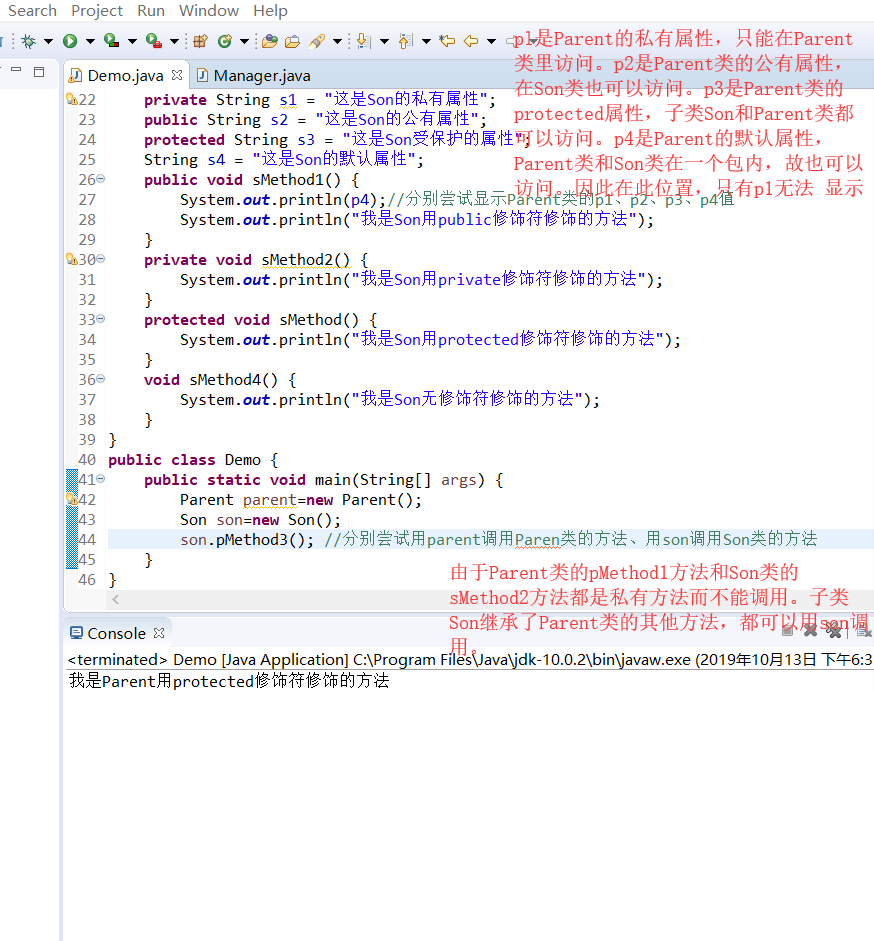
实验2:测试程序1(15分)
运行教材程序5-8、5-9、5-10,结合程序运行结果理解程序(教材174页-177页);
删除程序中Employee类、Manager类中的equals()、hasCode()、toString()方法,背录删除方法,在代码录入中理解类中重写Object父类方法的技术要点。
EqualsTest.java
package equals;
/**
* This program demonstrates the equals method.
* @version 1.12 2012-01-26
* @author Cay Horstmann
*/
public class EqualsTest
{
public static void main(String[] args)
{
var alice1 = new Employee("Alice Adams", 75000, 1987, 12, 15);
var alice2 = alice1;
var alice3 = new Employee("Alice Adams", 75000, 1987, 12, 15);
var bob = new Employee("Bob Brandson", 50000, 1989, 10, 1);
System.out.println("alice1 == alice2: " + (alice1 == alice2));//比较两个枚举类型的值是否相等
System.out.println("alice1 == alice3: " + (alice1 == alice3));
System.out.println("alice1.equals(alice3): " + alice1.equals(alice3));//比较两个字符串的内容是否相同
System.out.println("alice1.equals(bob): " + alice1.equals(bob));
System.out.println("bob.toString(): " + bob);
var carl = new Manager("Carl Cracker", 80000, 1987, 12, 15);
var boss = new Manager("Carl Cracker", 80000, 1987, 12, 15);
boss.setBonus(5000);
System.out.println("boss.toString(): " + boss);
System.out.println("carl.equals(boss): " + carl.equals(boss));
System.out.println("alice1.hashCode(): " + alice1.hashCode());//导出alice1对象的散列码
System.out.println("alice3.hashCode(): " + alice3.hashCode());
System.out.println("bob.hashCode(): " + bob.hashCode());
System.out.println("carl.hashCode(): " + carl.hashCode());
}
}
Employee.java
package equals;
import java.time.*;
import java.util.Objects;
public class Employee
{
private String name;
private double salary;
private LocalDate hireDay;
public Employee(String name, double salary, int year, int month, int day)
{
this.name = name;
this.salary = salary;
hireDay = LocalDate.of(year, month, day);
}
public String getName()
{
return name;
}
public double getSalary()
{
return salary;
}
public LocalDate getHireDay()
{
return hireDay;
}
public void raiseSalary(double byPercent)
{
double raise = salary * byPercent / 100;
salary += raise;
}
@Override
public int hashCode() {
// TODO Auto-generated method stub
return Objects.hash(name, salary, hireDay);
}
@Override
public boolean equals(Object otherObject) {
// TODO Auto-generated method stub
if (this == otherObject) return true;
if (otherObject == null) return false;
if (getClass() != otherObject.getClass()) return false;
var other = (Employee) otherObject;
return Objects.equals(name, other.name)
&& salary == other.salary && Objects.equals(hireDay, other.hireDay);
}
@Override
public String toString() {
// TODO Auto-generated method stub
return getClass().getName() + "[name=" + name + ",salary=" + salary + ",hireDay="
+ hireDay + "]";
}
}
Manager.java
package equals;
public class Manager extends Employee//子类Manager继承父类Employee
{
private double bonus;
public Manager(String name, double salary, int year, int month, int day)
{
super(name, salary, year, month, day);//调用父类构造器
bonus = 0;
}
public double getSalary()
{
double baseSalary = super.getSalary();//调用父类方法
return baseSalary + bonus;
}
public void setBonus(double bonus)
{
this.bonus = bonus;
}
@Override
public int hashCode() {
// TODO Auto-generated method stub
return java.util.Objects.hash(super.hashCode(), bonus);
}
@Override
public boolean equals(Object otherObject) {
// TODO Auto-generated method stub
if (!super.equals(otherObject)) return false;
var other = (Manager) otherObject;
// super.equals checked that this and other belong to the same class
return bonus == other.bonus;
}
@Override
public String toString() {
// TODO Auto-generated method stub
return super.toString() + "[bonus=" + bonus + "]";
}
}

实验2:测试程序2(15分)
l在elipse IDE中调试运行程序5-11(教材182页),结合程序运行结果理解程序;
掌握ArrayList类的定义及用法;
在程序中相关代码处添加新知识的注释;
设计适当的代码,测试ArrayList类的set()、get()、remove()、size()等方法的用法。
ArrayListTest.java
package arrayList;
import java.util.*;
/**
* This program demonstrates the ArrayList class.
* @version 1.11 2012-01-26
* @author Cay Horstmann
*/
public class ArrayListTest
{
public static void main(String[] args)
{
// 用Employee对象填充staff数组列表
var staff = new ArrayList<Employee>();
staff.add(new Employee("Carl Cracker", 75000, 1987, 12, 15));//把元素添加到数组列表的末尾
staff.add(new Employee("Harry Hacker", 50000, 1989, 10, 1));
staff.add(new Employee("Tony Tester", 40000, 1990, 3, 15));
// for each循环
for (Employee e : staff)
e.raiseSalary(5);
// 输出所有Employee对象的信息
for (Employee e : staff)
System.out.println("name=" + e.getName() + ",salary=" + e.getSalary() + ",hireDay="
+ e.getHireDay());
}
}
Employee.java
package arrayList;
import java.time.*;
public class Employee
{
private String name;
private double salary;
private LocalDate hireDay;
public Employee(String name, double salary, int year, int month, int day)
{
this.name = name;
this.salary = salary;
hireDay = LocalDate.of(year, month, day);
}
public String getName()
{
return name;
}
public double getSalary()
{
return salary;
}
public LocalDate getHireDay()
{
return hireDay;
}
public void raiseSalary(double byPercent)
{
double raise = salary * byPercent / 100;
salary += raise;
}
}
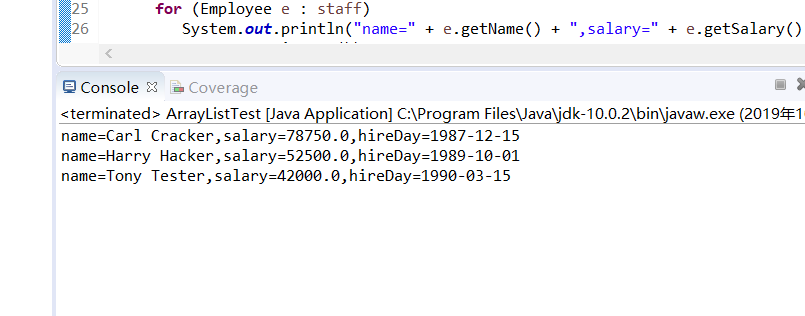
在ArrayListTest.java中添加
Employee b=staff.remove(1);//移除第一个位置上存放的对象,并将后面的元素向前移

System.out.println(staff.size());//返回当前数组列表中的元素个数

Employee a=new Employee("Wang",10000,1999,2,15);
staff.set(1, a);//将a放入数组列表的第1个位置,将这个位置原有的内容覆盖

Employee b=staff.get(2);//得到第二个位置的元素值
staff.add(b);//并将得到的元素值追加在数组列表的末尾

实验2:测试程序3(15分)
编辑、编译、调试运行程序5-12(教材189页),结合运行结果理解程序;
掌握枚举类的定义及用法;
在程序中相关代码处添加新知识的注释;
删除程序中Size枚举类,背录删除代码,在代码录入中掌握枚举类的定义要求。
package enums;
import java.util.*;
/**
* This program demonstrates enumerated types.
* @version 1.0 2004-05-24
* @author Cay Horstmann
*/
public class EnumTest
{
public static void main(String[] args)
{
var in = new Scanner(System.in);
System.out.print("Enter a size: (SMALL, MEDIUM, LARGE, EXTRA_LARGE) ");
String input = in.next().toUpperCase();
Size size = Enum.valueOf(Size.class, input);
System.out.println("size=" + size);
System.out.println("abbreviation=" + size.getAbbreviation());
if (size == Size.EXTRA_LARGE)//比较两个枚举类型的值
System.out.println("Good job--you paid attention to the _.");
}
}
enum Size//声明枚举类
{
SMALL("S"), MEDIUM("M"), LARGE("L"), EXTRA_LARGE("XL");
private Size(String abbreviation) { this.abbreviation = abbreviation; }
public String getAbbreviation() { return abbreviation; }
private String abbreviation;
}
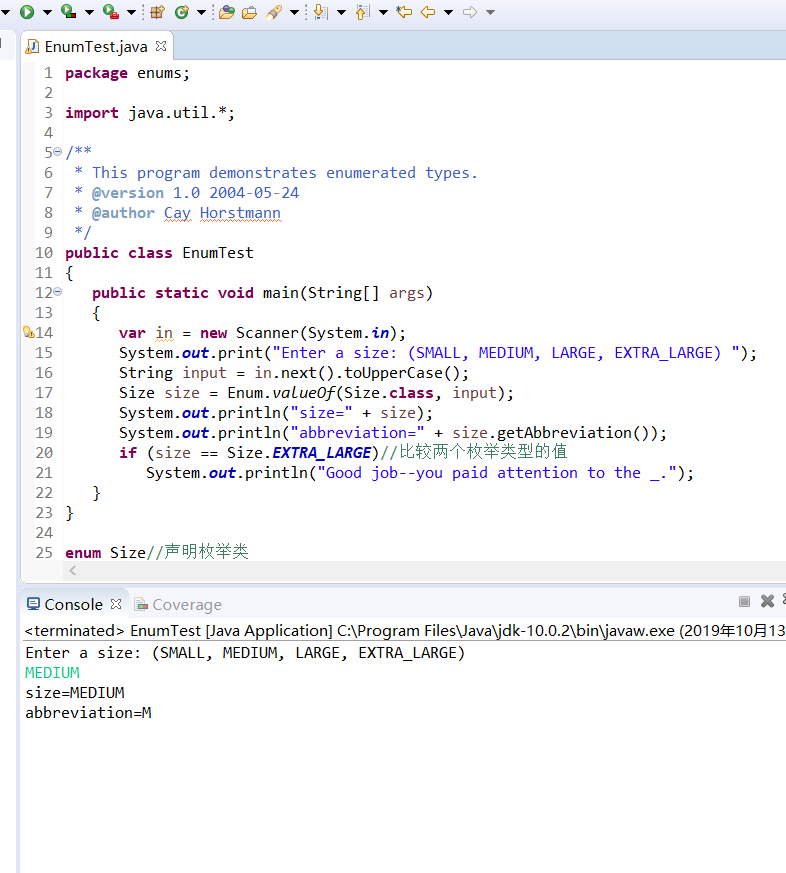
实验2:测试程序4(5分)
public class TestVarArgus {
public static void dealArray(int... intArray){ 参数数量可变
for (int i : intArray) //for each循环
System.out.print(i +" ");
System.out.println();
}
public static void main(String args[]){
dealArray();
dealArray(1);
dealArray(1, 2, 3);
}
}
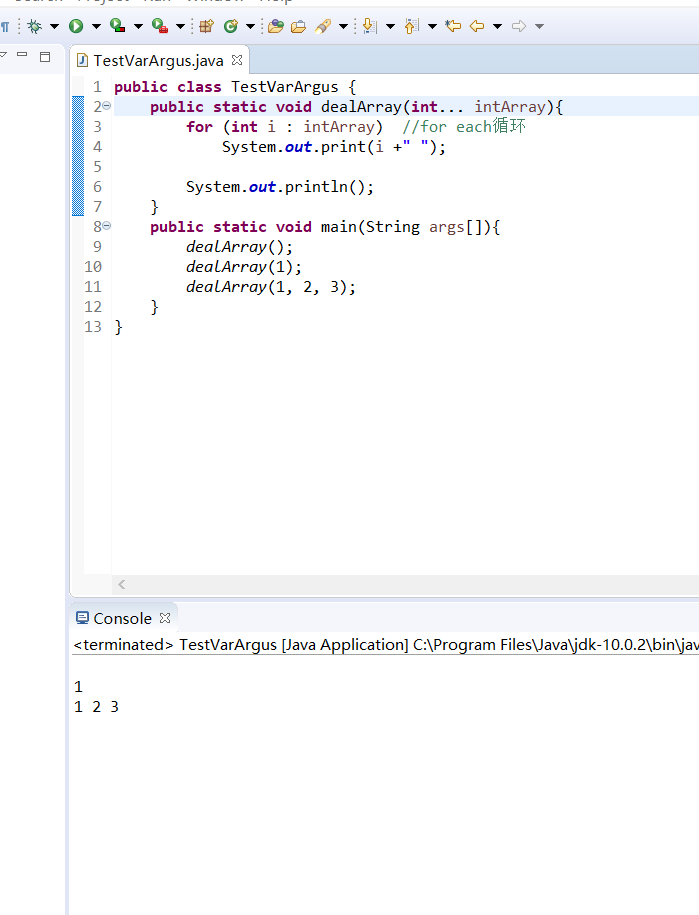
实验3:编程练习(10分)
package Parent1;
public class Demo {
public static void main(String[] args) {
Son son = new Son();
son.method();
}
}
class Parent {
Parent() {
System.out.println("Parent's Constructor without parameter");
}
Parent(boolean b) {
System.out.println("Parent's Constructor with a boolean parameter");
}
public void method() {
System.out.println("Parent's method()");
}
}
class Son extends Parent {
Son() {
super(true);
System.out.println("Son's Constructor without parameter");
}
public void method() {
System.out.println("Son's method()");
super.method();
}
}
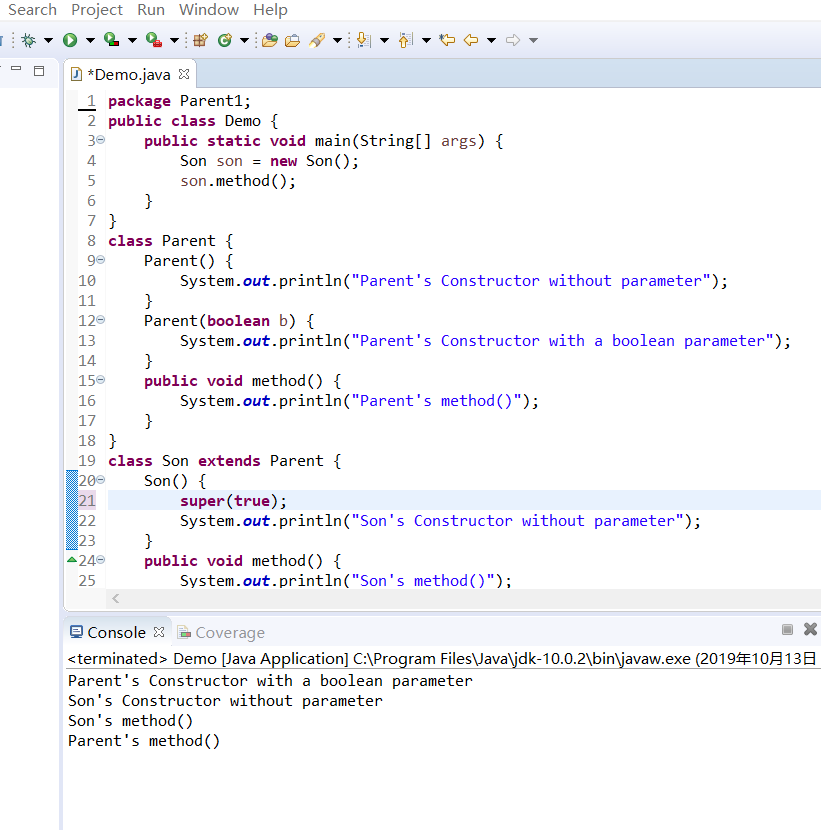
实验总结:在本周的学习下,更深层次的学习了继承,理解并运用。以及object类。通过实验课老师及学长的讲解,对私有属性,公有属性,protected属性,默认属性四种属性的理解以及应用。
object类作为所有类的父类,不能在拓展父类,以及不能在拓展子类的final类。泛型数组列表和枚举类的学习。